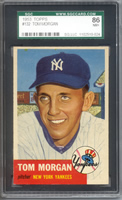| 100 PRISTINE: A "virtually flawless" card. 50/50 centering, crisp focus, four sharp corners*, free of stains, no breaks in surface gloss, no print or refractor lines, and no visible wear under magnification. |
| 98 GEM 10: 55/45 or better centering, sharp focus, four sharp corners*, free of stains, no breaks in surface gloss, no print or refractor lines, and no visible wear. A slight print spot visible under close scrutiny is allowable if it does not detract from the aesthetics of the card. |
| 96 MINT 9: 60/40 or betting centering, sharp focus and four sharp corners*. A minor flaw may exist upon close examination. A minor flaw may be, but is not limited to: a slight nick to one corner, a small gloss break or surface scratch, a minor print line or minor refractor line, a minor focus or color imperfection, or a small print spot. |
| 92 NM/MT+ 8.5: 65/35 or better centering, four sharp corners*. A few minor flaws may exist upon close examination. A minor flaw may be, but is not limited to: a slight nick to one corner, a small gloss break or surface scratch, a minor print line or minor refractor line, a minor focus or color imperfection, or a small print spot. |
| 88 NM/MT 8: 65/35 or better centering, corners sharp to the naked eye but may exhibit slight wear under closer examination. A few small flaws may exist upon close examination. A small flaw may be, but is not limited to: very minor wear on one corner, a gloss break or surface scratch, a print line or refractor line, a focus or color imperfection, or a print spot. |
| 86 NM+ 7.5: 70/30 or better centering, a few small flaws may exist upon close examination. A small flaw may be, but is not limited to: very minor wear on one corner, a gloss break or surface scratch, a print line or refractor line, a focus or color imperfection, or a print spot. |
| 84 NRMT 7: 70/30 or better centering, slight wear on some corners, minor scratching, some print spots or speckling, and print lines or refractor lines are acceptable. Card may exhibit a slightly skewed (diamond) cut. |
| 80 EX/NM 6: 75/25 or better centering, slight fuzzing of corners may be evident, skewed cut may be more evident, focus or register may be off, and slight notching of edges may exist. |
| 70 EX+ 5.5: A 60 EX 5 card with higher grade centering or corners. |
| 60 EX 5: 80/20 or better centering, minor rounding or fuzzing of corners, roughness or chipping along edge (no layering), one VERY slight surface or "spider" crease may exist on one side of the card, gloss may be lost from surface with some scratching that does not detract from the aesthetics of the card. |
| 50 VG/EX 4: 85/15 or better centering, corners are slightly rounded with modest surface wear. Light hairline crease may show on one or both sides. A light tear or surface break may exist. |
| 40 VG 3: 90/10 or better centering, corners more rounded--but not excessive, stronger creasing may exist. Poorer focus, registration, and discoloration, and staining are more noticeable. |
| 20 FAIR 1.5: Centered 90/10 or better. This card usually exhibits several of these characteristics: heavy print spots, heavy crease(s), pinhole(s), color or focus imperfections or discoloration, surface scuffing or tears, rounded and/or fraying corners, ink or pencil marking(s), and lack of all or some original gloss, a small portion of the card may be missing. |
| 30 GOOD 2: Centered 90/10 or better. This card usually exhibits one or more of these characteristics: heavy print spots, heavy crease(s), pinhole(s), color or focus imperfections or discoloration, surface scuffing or tear, rounded and/or fraying corners, ink or pencil marking(s), and lack of all or some original gloss. |
| 10 POOR 1: This card usually exhibits many of these characteristics: heavy print spots, heavy crease(s), pinhole(s), color or focus imperfections or discoloration, surface scuffing or tears, rounded and/or fraying corners, ink or pencil marking(s), and lack of all or some original gloss, small portions of the card may be missing. |
*Cards with round corners (i.e. Pokemon, Playing Cards, etc.) should exhibit clean, flat corners with the corner arc unencumbered. |
|
|
Definitions
CENTERING: Tolerances are allowed for centering but must be within 5% of the standard and should not detract from the overall eye-appeal of the card. Back centering is less critical than front centering and a tolerance of up to 10% in excess of the front standard is allowed.
BLEACHED: Generic term for the chemical process of cleaning or removing stains or dirt.
BORDERS: The framing style used for most cards.
ERASURE: Removal of portions of the text or print from the card.
FULL BLEED: Cards that do not have borders. Implied centering is used to determine centering characteristics for these issues.
GLOSS: The original surface coating or surface material.
IMPLIED CENTERING: Centering determination made on full bleed cards utilizing various aspects of the card's production.
REBUILT: Addition of material to recreate card structure. Usually used to recreate worn or missing corners.
RESURFACING: Addition of glaze or other substances to recreate surface structure.
SKEW: Characteristic of a mis-cut card. The card is not squarely cut, resembles more of a diamond shape. Opposite edges are parallel, but the corners are not 90 degrees.
SURFACE: May be affected by scratches, impressions, incomplete embossing of foil, or misaligned finish or embossing. |
